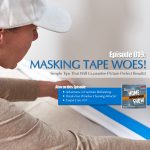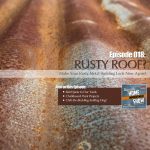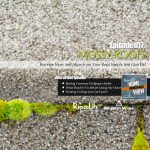Paint projects shouldn’t be daunting. Or complicated. Most of the time, any struggles we’ve ever had come from not knowing a few tricks that the professionals know. Today we talk about a number of ways to get beautiful results whenever you use masking tape!
Listen here:
Show notes for episode 019:
Some people may have heard this segment before, but Kim DeBoer had such good information. She told us where to find furniture to refinish and how to tell if it's worth buying. It's a project that is well worth the time and effort. You end up with a truly unique, one of a kind piece of furniture you can be proud of.
Kim DeBoer is a professional painting contractor who does a lot of furniture refinishing on the side. She's been doing this for herself and her customers for years!

We took Kim's advice and went hunting for the perfect piece. We picked up this very sad looking desk for about $50, but thought it might have potential. We were pleasantly surprised to find a beautiful wood top under many layers of paint. We now have a one-of-a-kind desk that we can be proud of!

Have you ever finished a painting project, all excited to pull the tape off and see the fruits of your labor, only to find that paint has bled under the tape and you now have all kinds of touch up to do?
We've all been there. Our paint project goes so well until the tape comes off. Maybe paint has bled under the tape. Maybe the tape pulled paint off the wall. We've got some of the most common tape complaints, when it comes to painting, and the solutions for them.
Many of us dread washing windows because it takes so long and it's so hard to get them streak and spot free. As soon as the sun is at just the right angle, we can see (very clearly!) every swipe of the rag we made.
We tried the top three window cleaning solutions we found on the internet, and this is the one we thought worked the best.Magic Cleaner #1
1/2 gal. warm water
1 Tbsp. Jet Dry
2-3 Tbsp. Dawn
The other solutions we tried were:Magic Cleaner #2
1/2 bottle Jet Dry
4 Tbsp. Alcohol
1/4 c. ammonia
1 handful powdered dishwasher soap
2 gal. hot water
Magic Cleaner #3
2 c. water
1/4 c. vinegar
1/2 tsp Dawn
New carpet is a huge investment and no one wants to do it often. But most people are unaware that the way they clean their carpet and what they clean it with, can actually void their warranty or even wear it out faster.
Nick Sargent from Johnson Carpet One joins us in the studio to discuss the finer points of carpet care.
And in the segment, Nick talks about Capture Carpet Cleaner. We said we'd include a link. And here it is!







 The first thing we tested was a right angle attachment. It's great for tight spots where you would normally have to angle the drill and still not have a straight shot at drilling a hole or tightening a screw. It's made for an impact driver, but can be used with a regular drill.
The first thing we tested was a right angle attachment. It's great for tight spots where you would normally have to angle the drill and still not have a straight shot at drilling a hole or tightening a screw. It's made for an impact driver, but can be used with a regular drill. These drywall screw setters are great for setting drywall screws to just the perfect depth. You don't have to worry about a giant crater in the drywall or going through the paper. They help you achieve professional looking results every time.
These drywall screw setters are great for setting drywall screws to just the perfect depth. You don't have to worry about a giant crater in the drywall or going through the paper. They help you achieve professional looking results every time.
 This drill and driver combo is a huge time saver! Many people alternate between a drilling holes and driving screws. They take one tool out, set it aside, and replace it with a new one. This often leads to missing tools. This eliminates that. Basically, it’s a bit that has a drill bit on one end and a driver bit on the other that you flip , depending on your task. It saves a lot of time searching for missing drill bit!
This drill and driver combo is a huge time saver! Many people alternate between a drilling holes and driving screws. They take one tool out, set it aside, and replace it with a new one. This often leads to missing tools. This eliminates that. Basically, it’s a bit that has a drill bit on one end and a driver bit on the other that you flip , depending on your task. It saves a lot of time searching for missing drill bit!
 These are Betsy's favorite drill accessory! No tool box should be without a set of easy outs. They make fast work of removing screws the have stripped heads. Betsy tried the "rubber band trick" and it didn't work, so she has been a fan of these every since.
These are Betsy's favorite drill accessory! No tool box should be without a set of easy outs. They make fast work of removing screws the have stripped heads. Betsy tried the "rubber band trick" and it didn't work, so she has been a fan of these every since.
 We are aware that keyless chucks have made accessory changing a lot faster than keyed chucks. But we have found the even faster way. This quick change adapter will have you changing out tools in a flash.
And finally, we tried out the new Hyde Stir Whip. It made quick work of mixing paint, and the fact that it can mix grout and concrete as well, makes it a must have accessory in our book!
Watch the Hyde Stir Whip in action!
We are aware that keyless chucks have made accessory changing a lot faster than keyed chucks. But we have found the even faster way. This quick change adapter will have you changing out tools in a flash.
And finally, we tried out the new Hyde Stir Whip. It made quick work of mixing paint, and the fact that it can mix grout and concrete as well, makes it a must have accessory in our book!
Watch the Hyde Stir Whip in action!

 Green lawns are something we all strive for. A sprinkler system may help. But for those with an older system, it can be very complicated.
Aaron Katerberg from Grapids Irrigation joins us in the studio once again. This time he tells us all about the newest technology in sprinkler systems. The best news is, many things can be retrofitted to older systems.
Green lawns are something we all strive for. A sprinkler system may help. But for those with an older system, it can be very complicated.
Aaron Katerberg from Grapids Irrigation joins us in the studio once again. This time he tells us all about the newest technology in sprinkler systems. The best news is, many things can be retrofitted to older systems. 